Research Proposal: Audi's Marketing Strategies and Competitor Analysis
VerifiedAdded on 2020/02/18
|22
|3979
|431
Report
AI Summary
This research proposal examines the underperformance of Audi in the luxury car market, comparing its marketing strategies with those of BMW and Mercedes-Benz. The study delves into Audi's current marketing approaches, analyzing their effectiveness and identifying areas for improvement. It explores various marketing models such as McKinsey 7s and AIDA to provide a comprehensive understanding of the marketing landscape. The research investigates the reasons behind Audi's challenges and suggests strategies to enhance its competitiveness and market share. The proposal outlines the research methodology, including data collection methods, research philosophy, and ethical considerations, to ensure a robust and reliable analysis of the topic. The literature review covers key concepts in marketing, marketing strategies, and their impact on organizational performance, providing a solid foundation for the research. The ultimate goal is to provide insights that will help Audi regain its position in the luxury car market. The report covers all aspects from introduction to literature review to research methodology.

Running head: RESEARCH PROPOSAL
Research proposal
Name of the student:
Name of the University:
Author note:
Research proposal
Name of the student:
Name of the University:
Author note:
Paraphrase This Document
Need a fresh take? Get an instant paraphrase of this document with our AI Paraphraser
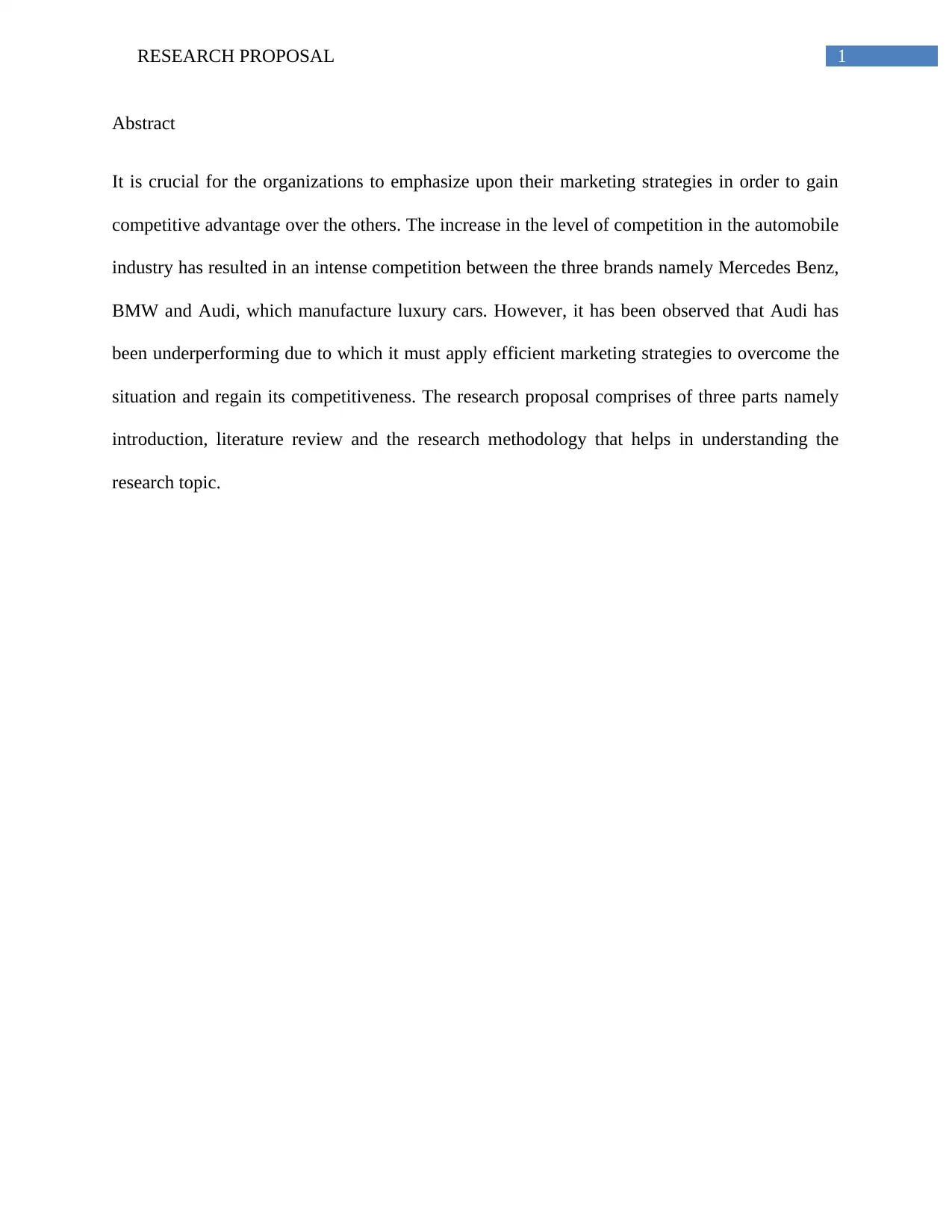
1RESEARCH PROPOSAL
Abstract
It is crucial for the organizations to emphasize upon their marketing strategies in order to gain
competitive advantage over the others. The increase in the level of competition in the automobile
industry has resulted in an intense competition between the three brands namely Mercedes Benz,
BMW and Audi, which manufacture luxury cars. However, it has been observed that Audi has
been underperforming due to which it must apply efficient marketing strategies to overcome the
situation and regain its competitiveness. The research proposal comprises of three parts namely
introduction, literature review and the research methodology that helps in understanding the
research topic.
Abstract
It is crucial for the organizations to emphasize upon their marketing strategies in order to gain
competitive advantage over the others. The increase in the level of competition in the automobile
industry has resulted in an intense competition between the three brands namely Mercedes Benz,
BMW and Audi, which manufacture luxury cars. However, it has been observed that Audi has
been underperforming due to which it must apply efficient marketing strategies to overcome the
situation and regain its competitiveness. The research proposal comprises of three parts namely
introduction, literature review and the research methodology that helps in understanding the
research topic.
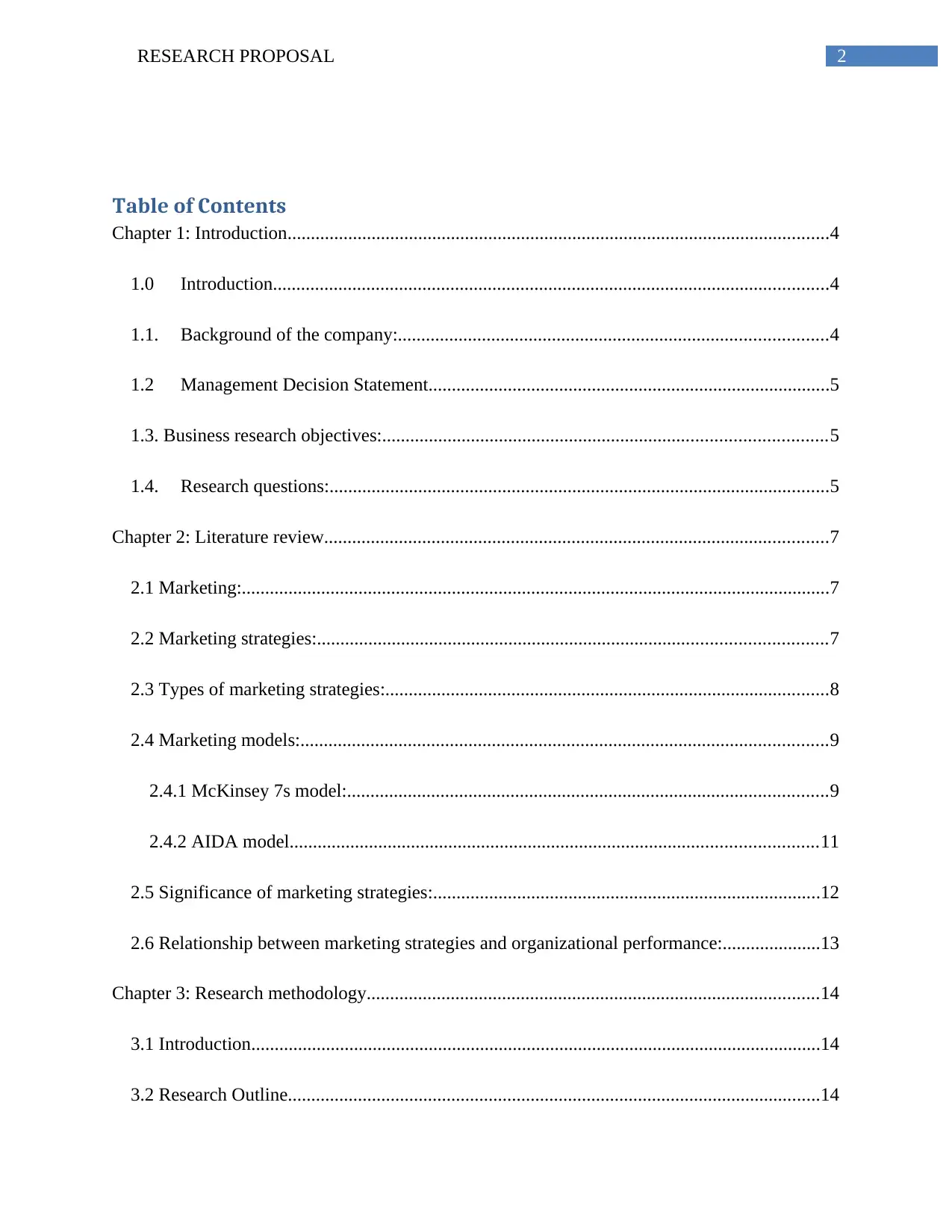
2RESEARCH PROPOSAL
Table of Contents
Chapter 1: Introduction....................................................................................................................4
1.0 Introduction.......................................................................................................................4
1.1. Background of the company:............................................................................................4
1.2 Management Decision Statement......................................................................................5
1.3. Business research objectives:...............................................................................................5
1.4. Research questions:...........................................................................................................5
Chapter 2: Literature review............................................................................................................7
2.1 Marketing:..............................................................................................................................7
2.2 Marketing strategies:.............................................................................................................7
2.3 Types of marketing strategies:...............................................................................................8
2.4 Marketing models:.................................................................................................................9
2.4.1 McKinsey 7s model:.......................................................................................................9
2.4.2 AIDA model.................................................................................................................11
2.5 Significance of marketing strategies:...................................................................................12
2.6 Relationship between marketing strategies and organizational performance:.....................13
Chapter 3: Research methodology.................................................................................................14
3.1 Introduction..........................................................................................................................14
3.2 Research Outline..................................................................................................................14
Table of Contents
Chapter 1: Introduction....................................................................................................................4
1.0 Introduction.......................................................................................................................4
1.1. Background of the company:............................................................................................4
1.2 Management Decision Statement......................................................................................5
1.3. Business research objectives:...............................................................................................5
1.4. Research questions:...........................................................................................................5
Chapter 2: Literature review............................................................................................................7
2.1 Marketing:..............................................................................................................................7
2.2 Marketing strategies:.............................................................................................................7
2.3 Types of marketing strategies:...............................................................................................8
2.4 Marketing models:.................................................................................................................9
2.4.1 McKinsey 7s model:.......................................................................................................9
2.4.2 AIDA model.................................................................................................................11
2.5 Significance of marketing strategies:...................................................................................12
2.6 Relationship between marketing strategies and organizational performance:.....................13
Chapter 3: Research methodology.................................................................................................14
3.1 Introduction..........................................................................................................................14
3.2 Research Outline..................................................................................................................14
⊘ This is a preview!⊘
Do you want full access?
Subscribe today to unlock all pages.

Trusted by 1+ million students worldwide
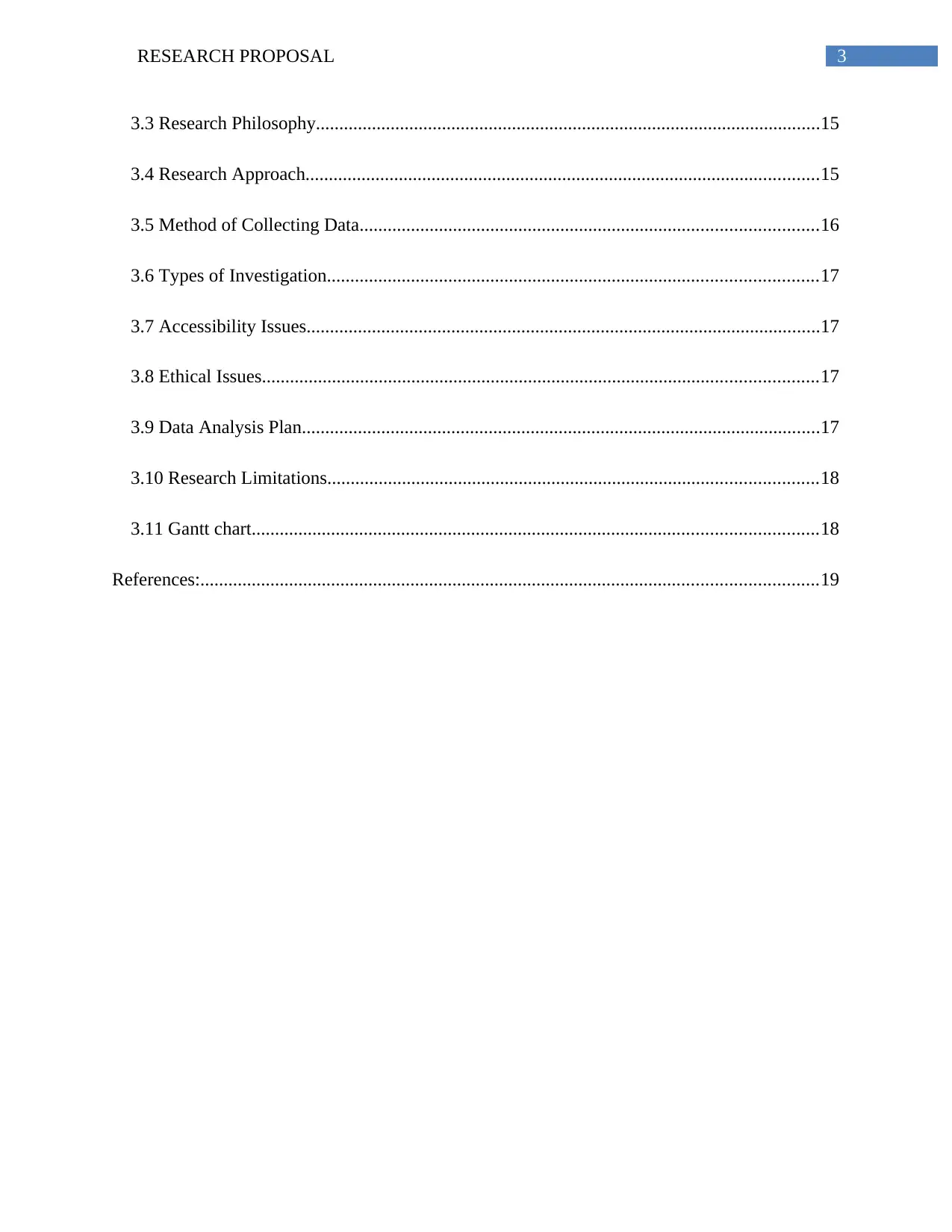
3RESEARCH PROPOSAL
3.3 Research Philosophy............................................................................................................15
3.4 Research Approach..............................................................................................................15
3.5 Method of Collecting Data..................................................................................................16
3.6 Types of Investigation.........................................................................................................17
3.7 Accessibility Issues..............................................................................................................17
3.8 Ethical Issues.......................................................................................................................17
3.9 Data Analysis Plan...............................................................................................................17
3.10 Research Limitations.........................................................................................................18
3.11 Gantt chart.........................................................................................................................18
References:....................................................................................................................................19
3.3 Research Philosophy............................................................................................................15
3.4 Research Approach..............................................................................................................15
3.5 Method of Collecting Data..................................................................................................16
3.6 Types of Investigation.........................................................................................................17
3.7 Accessibility Issues..............................................................................................................17
3.8 Ethical Issues.......................................................................................................................17
3.9 Data Analysis Plan...............................................................................................................17
3.10 Research Limitations.........................................................................................................18
3.11 Gantt chart.........................................................................................................................18
References:....................................................................................................................................19
Paraphrase This Document
Need a fresh take? Get an instant paraphrase of this document with our AI Paraphraser
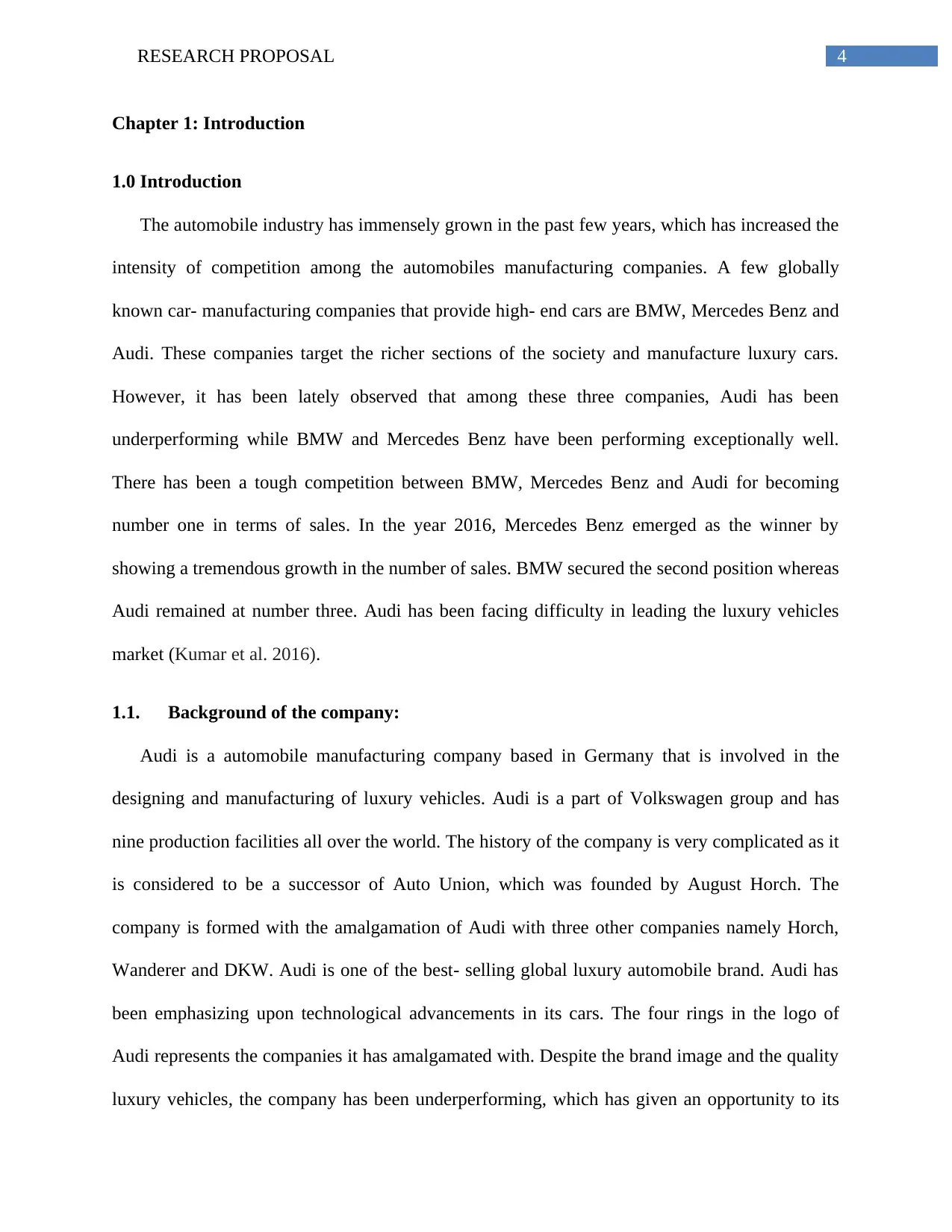
4RESEARCH PROPOSAL
Chapter 1: Introduction
1.0 Introduction
The automobile industry has immensely grown in the past few years, which has increased the
intensity of competition among the automobiles manufacturing companies. A few globally
known car- manufacturing companies that provide high- end cars are BMW, Mercedes Benz and
Audi. These companies target the richer sections of the society and manufacture luxury cars.
However, it has been lately observed that among these three companies, Audi has been
underperforming while BMW and Mercedes Benz have been performing exceptionally well.
There has been a tough competition between BMW, Mercedes Benz and Audi for becoming
number one in terms of sales. In the year 2016, Mercedes Benz emerged as the winner by
showing a tremendous growth in the number of sales. BMW secured the second position whereas
Audi remained at number three. Audi has been facing difficulty in leading the luxury vehicles
market (Kumar et al. 2016).
1.1. Background of the company:
Audi is a automobile manufacturing company based in Germany that is involved in the
designing and manufacturing of luxury vehicles. Audi is a part of Volkswagen group and has
nine production facilities all over the world. The history of the company is very complicated as it
is considered to be a successor of Auto Union, which was founded by August Horch. The
company is formed with the amalgamation of Audi with three other companies namely Horch,
Wanderer and DKW. Audi is one of the best- selling global luxury automobile brand. Audi has
been emphasizing upon technological advancements in its cars. The four rings in the logo of
Audi represents the companies it has amalgamated with. Despite the brand image and the quality
luxury vehicles, the company has been underperforming, which has given an opportunity to its
Chapter 1: Introduction
1.0 Introduction
The automobile industry has immensely grown in the past few years, which has increased the
intensity of competition among the automobiles manufacturing companies. A few globally
known car- manufacturing companies that provide high- end cars are BMW, Mercedes Benz and
Audi. These companies target the richer sections of the society and manufacture luxury cars.
However, it has been lately observed that among these three companies, Audi has been
underperforming while BMW and Mercedes Benz have been performing exceptionally well.
There has been a tough competition between BMW, Mercedes Benz and Audi for becoming
number one in terms of sales. In the year 2016, Mercedes Benz emerged as the winner by
showing a tremendous growth in the number of sales. BMW secured the second position whereas
Audi remained at number three. Audi has been facing difficulty in leading the luxury vehicles
market (Kumar et al. 2016).
1.1. Background of the company:
Audi is a automobile manufacturing company based in Germany that is involved in the
designing and manufacturing of luxury vehicles. Audi is a part of Volkswagen group and has
nine production facilities all over the world. The history of the company is very complicated as it
is considered to be a successor of Auto Union, which was founded by August Horch. The
company is formed with the amalgamation of Audi with three other companies namely Horch,
Wanderer and DKW. Audi is one of the best- selling global luxury automobile brand. Audi has
been emphasizing upon technological advancements in its cars. The four rings in the logo of
Audi represents the companies it has amalgamated with. Despite the brand image and the quality
luxury vehicles, the company has been underperforming, which has given an opportunity to its
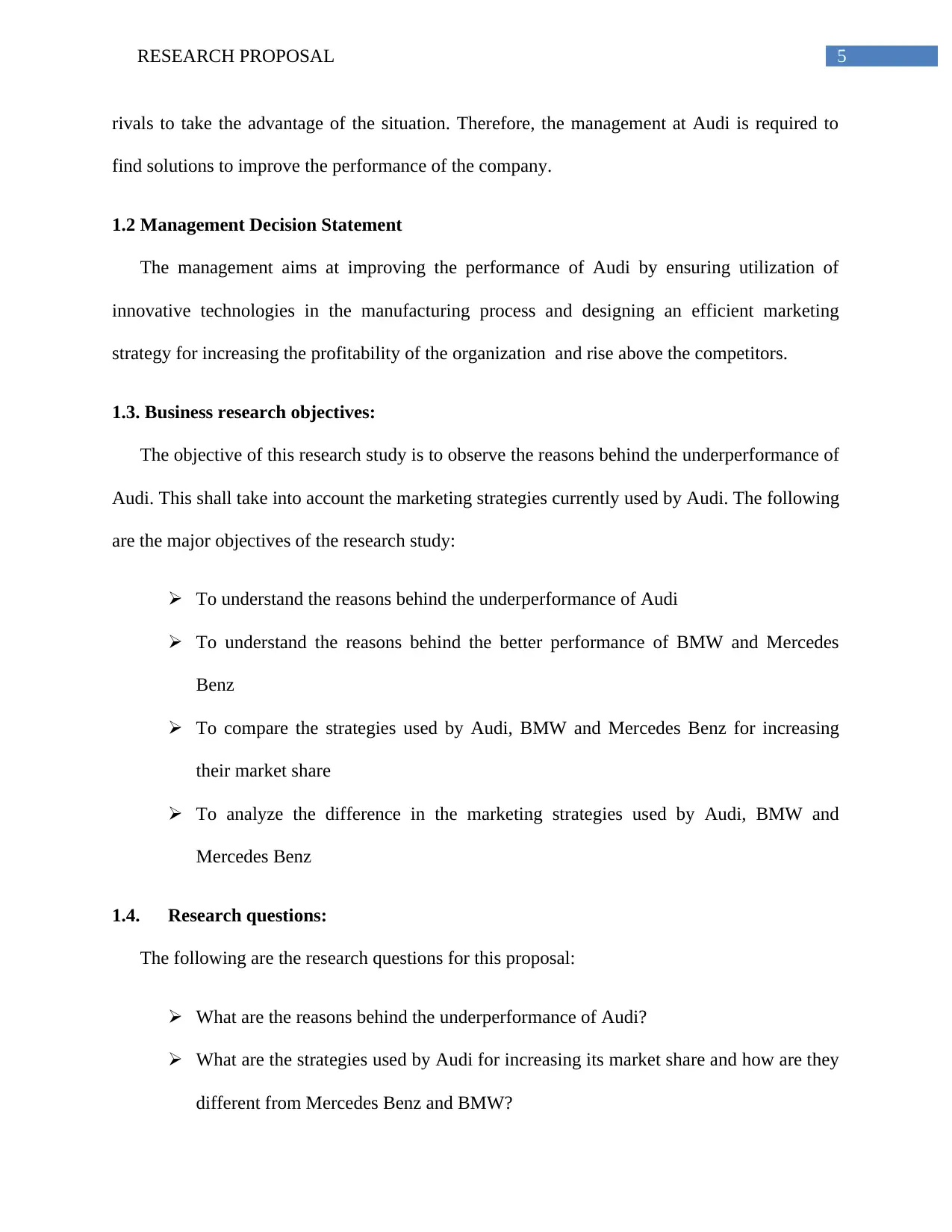
5RESEARCH PROPOSAL
rivals to take the advantage of the situation. Therefore, the management at Audi is required to
find solutions to improve the performance of the company.
1.2 Management Decision Statement
The management aims at improving the performance of Audi by ensuring utilization of
innovative technologies in the manufacturing process and designing an efficient marketing
strategy for increasing the profitability of the organization and rise above the competitors.
1.3. Business research objectives:
The objective of this research study is to observe the reasons behind the underperformance of
Audi. This shall take into account the marketing strategies currently used by Audi. The following
are the major objectives of the research study:
To understand the reasons behind the underperformance of Audi
To understand the reasons behind the better performance of BMW and Mercedes
Benz
To compare the strategies used by Audi, BMW and Mercedes Benz for increasing
their market share
To analyze the difference in the marketing strategies used by Audi, BMW and
Mercedes Benz
1.4. Research questions:
The following are the research questions for this proposal:
What are the reasons behind the underperformance of Audi?
What are the strategies used by Audi for increasing its market share and how are they
different from Mercedes Benz and BMW?
rivals to take the advantage of the situation. Therefore, the management at Audi is required to
find solutions to improve the performance of the company.
1.2 Management Decision Statement
The management aims at improving the performance of Audi by ensuring utilization of
innovative technologies in the manufacturing process and designing an efficient marketing
strategy for increasing the profitability of the organization and rise above the competitors.
1.3. Business research objectives:
The objective of this research study is to observe the reasons behind the underperformance of
Audi. This shall take into account the marketing strategies currently used by Audi. The following
are the major objectives of the research study:
To understand the reasons behind the underperformance of Audi
To understand the reasons behind the better performance of BMW and Mercedes
Benz
To compare the strategies used by Audi, BMW and Mercedes Benz for increasing
their market share
To analyze the difference in the marketing strategies used by Audi, BMW and
Mercedes Benz
1.4. Research questions:
The following are the research questions for this proposal:
What are the reasons behind the underperformance of Audi?
What are the strategies used by Audi for increasing its market share and how are they
different from Mercedes Benz and BMW?
⊘ This is a preview!⊘
Do you want full access?
Subscribe today to unlock all pages.

Trusted by 1+ million students worldwide

6RESEARCH PROPOSAL
What are the marketing strategies used by Audi?
What are the marketing strategies used by Audi?
Paraphrase This Document
Need a fresh take? Get an instant paraphrase of this document with our AI Paraphraser
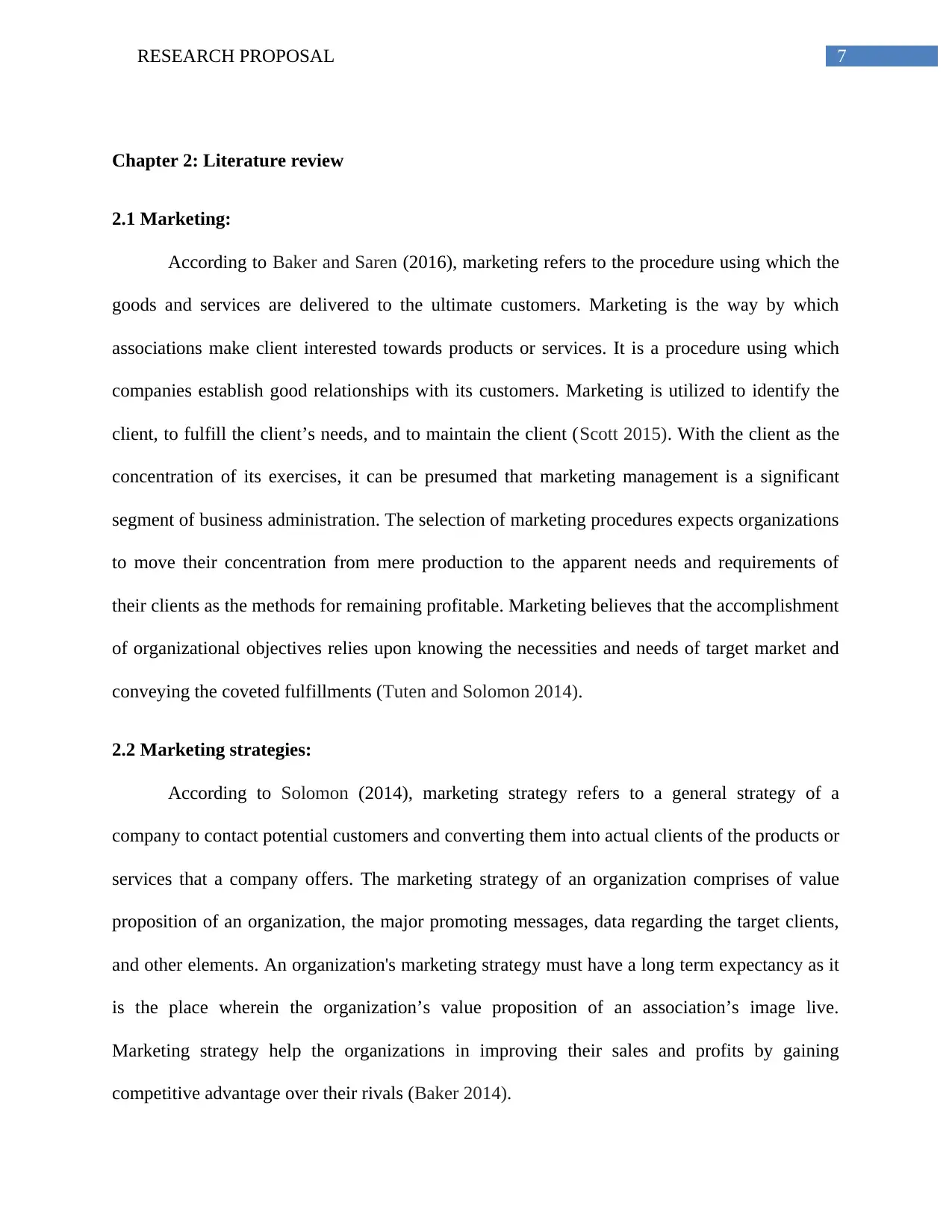
7RESEARCH PROPOSAL
Chapter 2: Literature review
2.1 Marketing:
According to Baker and Saren (2016), marketing refers to the procedure using which the
goods and services are delivered to the ultimate customers. Marketing is the way by which
associations make client interested towards products or services. It is a procedure using which
companies establish good relationships with its customers. Marketing is utilized to identify the
client, to fulfill the client’s needs, and to maintain the client (Scott 2015). With the client as the
concentration of its exercises, it can be presumed that marketing management is a significant
segment of business administration. The selection of marketing procedures expects organizations
to move their concentration from mere production to the apparent needs and requirements of
their clients as the methods for remaining profitable. Marketing believes that the accomplishment
of organizational objectives relies upon knowing the necessities and needs of target market and
conveying the coveted fulfillments (Tuten and Solomon 2014).
2.2 Marketing strategies:
According to Solomon (2014), marketing strategy refers to a general strategy of a
company to contact potential customers and converting them into actual clients of the products or
services that a company offers. The marketing strategy of an organization comprises of value
proposition of an organization, the major promoting messages, data regarding the target clients,
and other elements. An organization's marketing strategy must have a long term expectancy as it
is the place wherein the organization’s value proposition of an association’s image live.
Marketing strategy help the organizations in improving their sales and profits by gaining
competitive advantage over their rivals (Baker 2014).
Chapter 2: Literature review
2.1 Marketing:
According to Baker and Saren (2016), marketing refers to the procedure using which the
goods and services are delivered to the ultimate customers. Marketing is the way by which
associations make client interested towards products or services. It is a procedure using which
companies establish good relationships with its customers. Marketing is utilized to identify the
client, to fulfill the client’s needs, and to maintain the client (Scott 2015). With the client as the
concentration of its exercises, it can be presumed that marketing management is a significant
segment of business administration. The selection of marketing procedures expects organizations
to move their concentration from mere production to the apparent needs and requirements of
their clients as the methods for remaining profitable. Marketing believes that the accomplishment
of organizational objectives relies upon knowing the necessities and needs of target market and
conveying the coveted fulfillments (Tuten and Solomon 2014).
2.2 Marketing strategies:
According to Solomon (2014), marketing strategy refers to a general strategy of a
company to contact potential customers and converting them into actual clients of the products or
services that a company offers. The marketing strategy of an organization comprises of value
proposition of an organization, the major promoting messages, data regarding the target clients,
and other elements. An organization's marketing strategy must have a long term expectancy as it
is the place wherein the organization’s value proposition of an association’s image live.
Marketing strategy help the organizations in improving their sales and profits by gaining
competitive advantage over their rivals (Baker 2014).
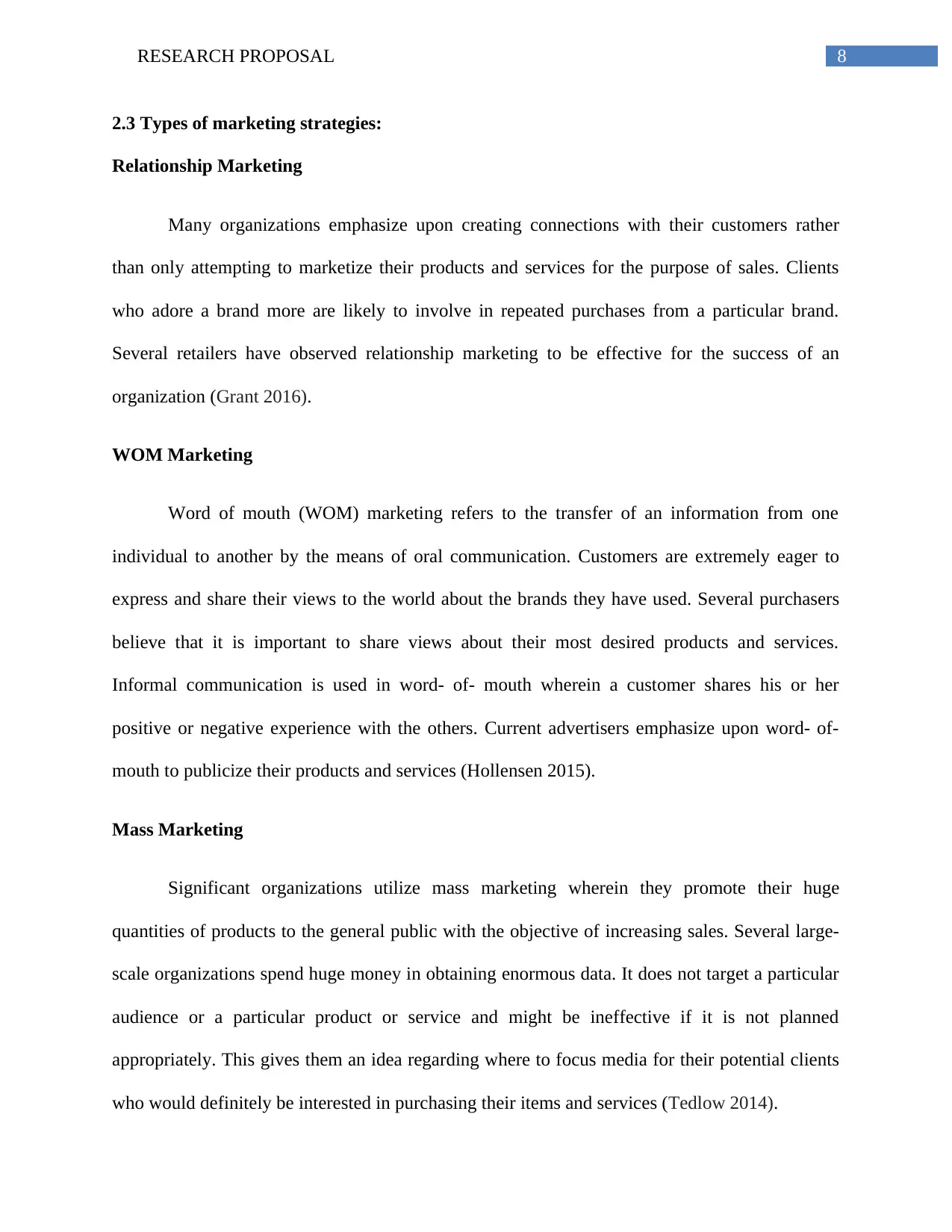
8RESEARCH PROPOSAL
2.3 Types of marketing strategies:
Relationship Marketing
Many organizations emphasize upon creating connections with their customers rather
than only attempting to marketize their products and services for the purpose of sales. Clients
who adore a brand more are likely to involve in repeated purchases from a particular brand.
Several retailers have observed relationship marketing to be effective for the success of an
organization (Grant 2016).
WOM Marketing
Word of mouth (WOM) marketing refers to the transfer of an information from one
individual to another by the means of oral communication. Customers are extremely eager to
express and share their views to the world about the brands they have used. Several purchasers
believe that it is important to share views about their most desired products and services.
Informal communication is used in word- of- mouth wherein a customer shares his or her
positive or negative experience with the others. Current advertisers emphasize upon word- of-
mouth to publicize their products and services (Hollensen 2015).
Mass Marketing
Significant organizations utilize mass marketing wherein they promote their huge
quantities of products to the general public with the objective of increasing sales. Several large-
scale organizations spend huge money in obtaining enormous data. It does not target a particular
audience or a particular product or service and might be ineffective if it is not planned
appropriately. This gives them an idea regarding where to focus media for their potential clients
who would definitely be interested in purchasing their items and services (Tedlow 2014).
2.3 Types of marketing strategies:
Relationship Marketing
Many organizations emphasize upon creating connections with their customers rather
than only attempting to marketize their products and services for the purpose of sales. Clients
who adore a brand more are likely to involve in repeated purchases from a particular brand.
Several retailers have observed relationship marketing to be effective for the success of an
organization (Grant 2016).
WOM Marketing
Word of mouth (WOM) marketing refers to the transfer of an information from one
individual to another by the means of oral communication. Customers are extremely eager to
express and share their views to the world about the brands they have used. Several purchasers
believe that it is important to share views about their most desired products and services.
Informal communication is used in word- of- mouth wherein a customer shares his or her
positive or negative experience with the others. Current advertisers emphasize upon word- of-
mouth to publicize their products and services (Hollensen 2015).
Mass Marketing
Significant organizations utilize mass marketing wherein they promote their huge
quantities of products to the general public with the objective of increasing sales. Several large-
scale organizations spend huge money in obtaining enormous data. It does not target a particular
audience or a particular product or service and might be ineffective if it is not planned
appropriately. This gives them an idea regarding where to focus media for their potential clients
who would definitely be interested in purchasing their items and services (Tedlow 2014).
⊘ This is a preview!⊘
Do you want full access?
Subscribe today to unlock all pages.

Trusted by 1+ million students worldwide
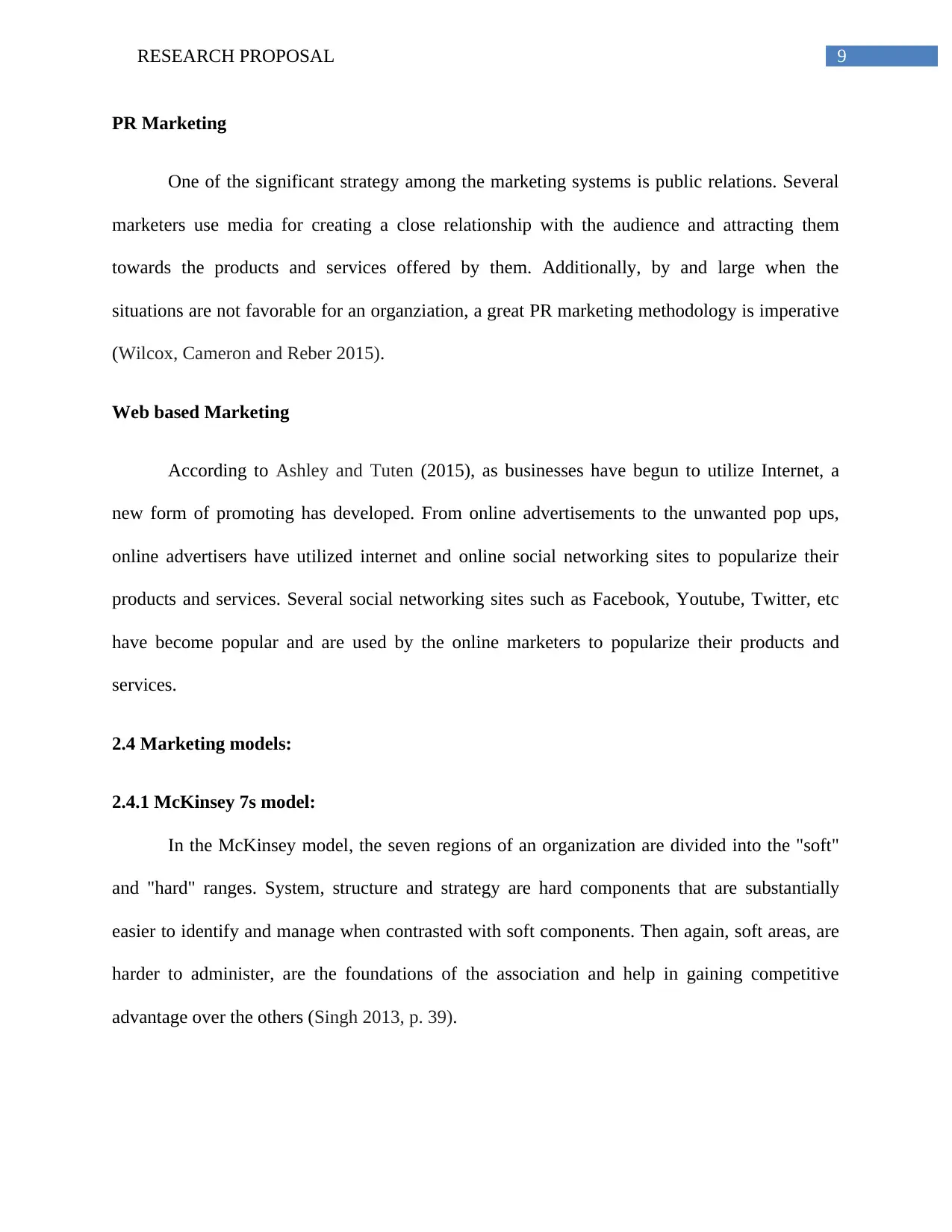
9RESEARCH PROPOSAL
PR Marketing
One of the significant strategy among the marketing systems is public relations. Several
marketers use media for creating a close relationship with the audience and attracting them
towards the products and services offered by them. Additionally, by and large when the
situations are not favorable for an organziation, a great PR marketing methodology is imperative
(Wilcox, Cameron and Reber 2015).
Web based Marketing
According to Ashley and Tuten (2015), as businesses have begun to utilize Internet, a
new form of promoting has developed. From online advertisements to the unwanted pop ups,
online advertisers have utilized internet and online social networking sites to popularize their
products and services. Several social networking sites such as Facebook, Youtube, Twitter, etc
have become popular and are used by the online marketers to popularize their products and
services.
2.4 Marketing models:
2.4.1 McKinsey 7s model:
In the McKinsey model, the seven regions of an organization are divided into the "soft"
and "hard" ranges. System, structure and strategy are hard components that are substantially
easier to identify and manage when contrasted with soft components. Then again, soft areas, are
harder to administer, are the foundations of the association and help in gaining competitive
advantage over the others (Singh 2013, p. 39).
PR Marketing
One of the significant strategy among the marketing systems is public relations. Several
marketers use media for creating a close relationship with the audience and attracting them
towards the products and services offered by them. Additionally, by and large when the
situations are not favorable for an organziation, a great PR marketing methodology is imperative
(Wilcox, Cameron and Reber 2015).
Web based Marketing
According to Ashley and Tuten (2015), as businesses have begun to utilize Internet, a
new form of promoting has developed. From online advertisements to the unwanted pop ups,
online advertisers have utilized internet and online social networking sites to popularize their
products and services. Several social networking sites such as Facebook, Youtube, Twitter, etc
have become popular and are used by the online marketers to popularize their products and
services.
2.4 Marketing models:
2.4.1 McKinsey 7s model:
In the McKinsey model, the seven regions of an organization are divided into the "soft"
and "hard" ranges. System, structure and strategy are hard components that are substantially
easier to identify and manage when contrasted with soft components. Then again, soft areas, are
harder to administer, are the foundations of the association and help in gaining competitive
advantage over the others (Singh 2013, p. 39).
Paraphrase This Document
Need a fresh take? Get an instant paraphrase of this document with our AI Paraphraser
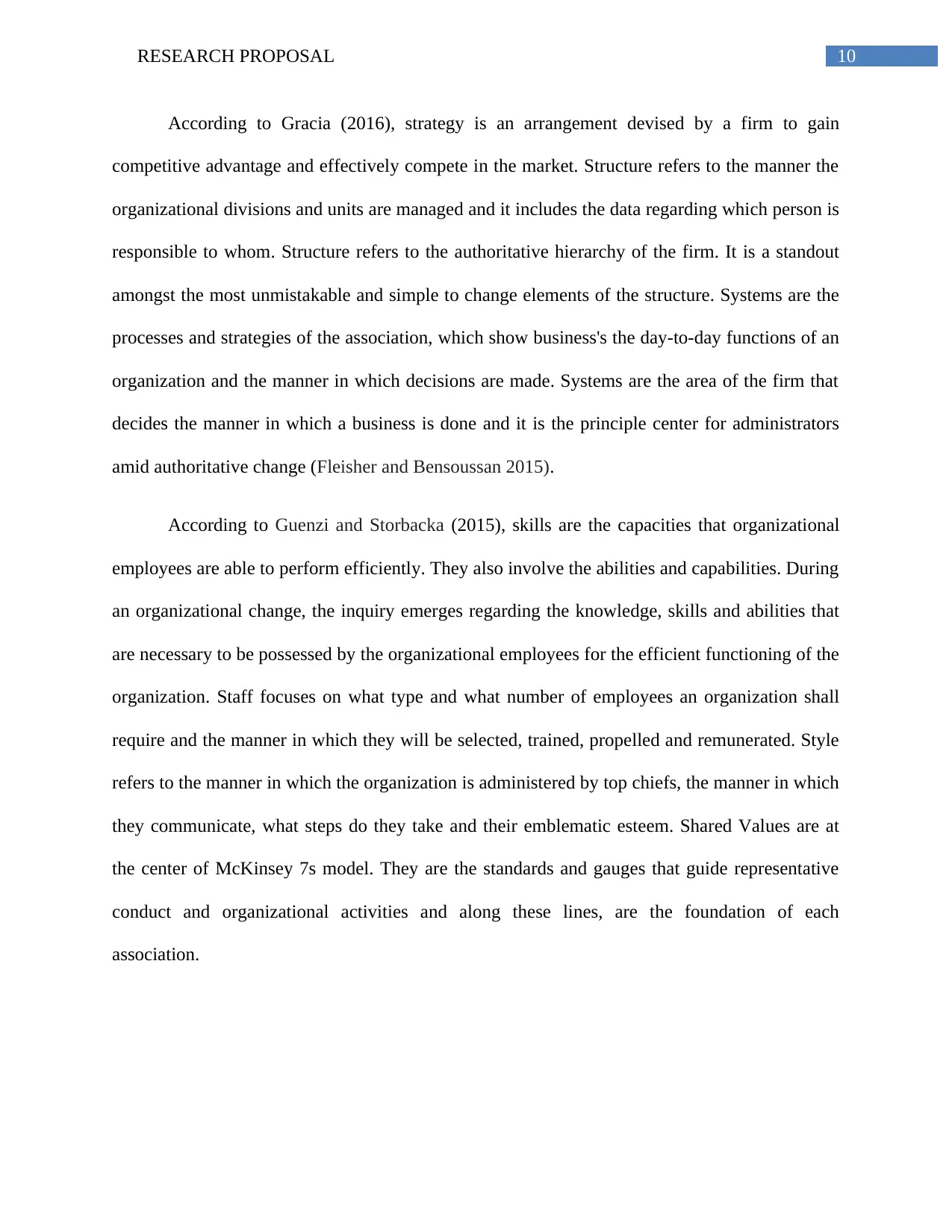
10RESEARCH PROPOSAL
According to Gracia (2016), strategy is an arrangement devised by a firm to gain
competitive advantage and effectively compete in the market. Structure refers to the manner the
organizational divisions and units are managed and it includes the data regarding which person is
responsible to whom. Structure refers to the authoritative hierarchy of the firm. It is a standout
amongst the most unmistakable and simple to change elements of the structure. Systems are the
processes and strategies of the association, which show business's the day-to-day functions of an
organization and the manner in which decisions are made. Systems are the area of the firm that
decides the manner in which a business is done and it is the principle center for administrators
amid authoritative change (Fleisher and Bensoussan 2015).
According to Guenzi and Storbacka (2015), skills are the capacities that organizational
employees are able to perform efficiently. They also involve the abilities and capabilities. During
an organizational change, the inquiry emerges regarding the knowledge, skills and abilities that
are necessary to be possessed by the organizational employees for the efficient functioning of the
organization. Staff focuses on what type and what number of employees an organization shall
require and the manner in which they will be selected, trained, propelled and remunerated. Style
refers to the manner in which the organization is administered by top chiefs, the manner in which
they communicate, what steps do they take and their emblematic esteem. Shared Values are at
the center of McKinsey 7s model. They are the standards and gauges that guide representative
conduct and organizational activities and along these lines, are the foundation of each
association.
According to Gracia (2016), strategy is an arrangement devised by a firm to gain
competitive advantage and effectively compete in the market. Structure refers to the manner the
organizational divisions and units are managed and it includes the data regarding which person is
responsible to whom. Structure refers to the authoritative hierarchy of the firm. It is a standout
amongst the most unmistakable and simple to change elements of the structure. Systems are the
processes and strategies of the association, which show business's the day-to-day functions of an
organization and the manner in which decisions are made. Systems are the area of the firm that
decides the manner in which a business is done and it is the principle center for administrators
amid authoritative change (Fleisher and Bensoussan 2015).
According to Guenzi and Storbacka (2015), skills are the capacities that organizational
employees are able to perform efficiently. They also involve the abilities and capabilities. During
an organizational change, the inquiry emerges regarding the knowledge, skills and abilities that
are necessary to be possessed by the organizational employees for the efficient functioning of the
organization. Staff focuses on what type and what number of employees an organization shall
require and the manner in which they will be selected, trained, propelled and remunerated. Style
refers to the manner in which the organization is administered by top chiefs, the manner in which
they communicate, what steps do they take and their emblematic esteem. Shared Values are at
the center of McKinsey 7s model. They are the standards and gauges that guide representative
conduct and organizational activities and along these lines, are the foundation of each
association.
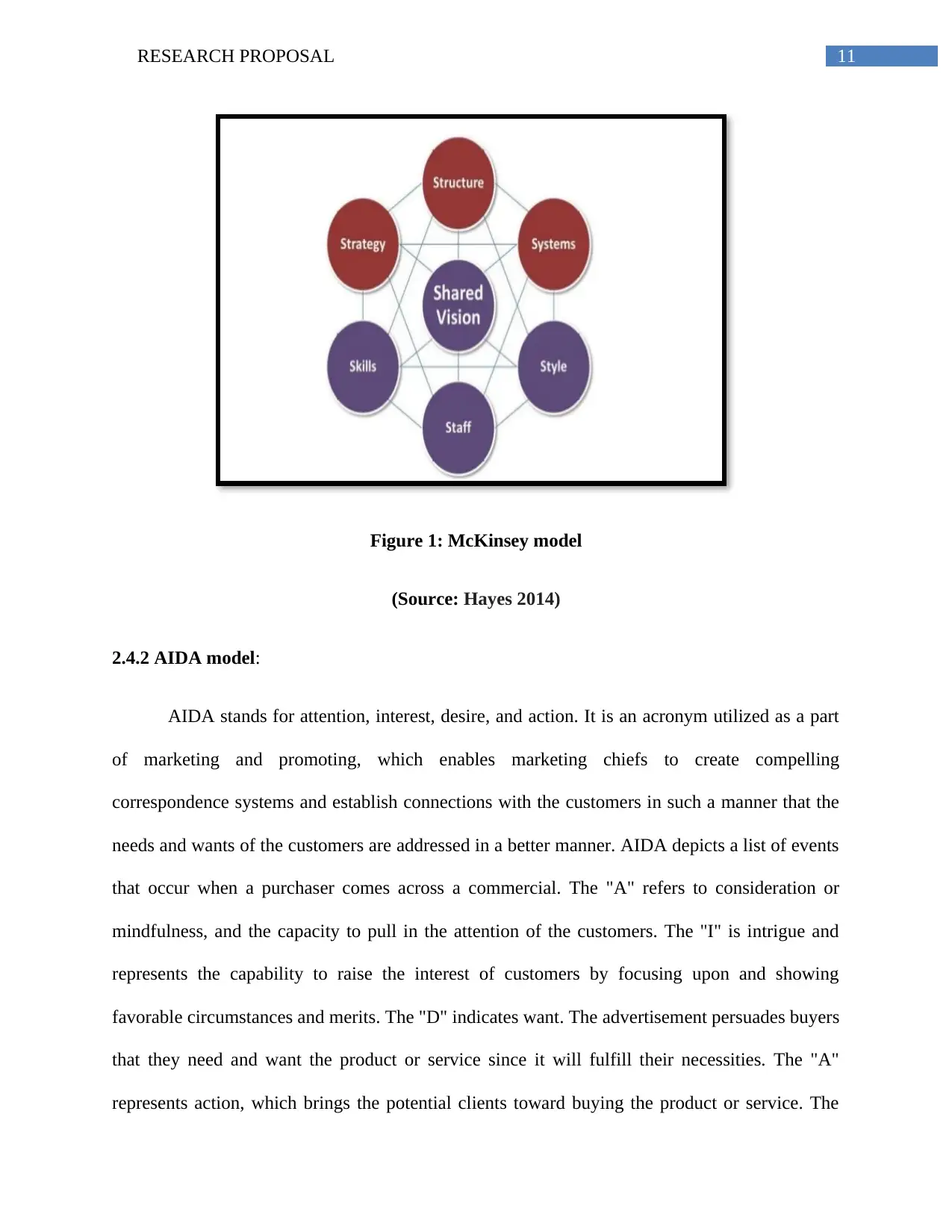
11RESEARCH PROPOSAL
Figure 1: McKinsey model
(Source: Hayes 2014)
2.4.2 AIDA model:
AIDA stands for attention, interest, desire, and action. It is an acronym utilized as a part
of marketing and promoting, which enables marketing chiefs to create compelling
correspondence systems and establish connections with the customers in such a manner that the
needs and wants of the customers are addressed in a better manner. AIDA depicts a list of events
that occur when a purchaser comes across a commercial. The "A" refers to consideration or
mindfulness, and the capacity to pull in the attention of the customers. The "I" is intrigue and
represents the capability to raise the interest of customers by focusing upon and showing
favorable circumstances and merits. The "D" indicates want. The advertisement persuades buyers
that they need and want the product or service since it will fulfill their necessities. The "A"
represents action, which brings the potential clients toward buying the product or service. The
Figure 1: McKinsey model
(Source: Hayes 2014)
2.4.2 AIDA model:
AIDA stands for attention, interest, desire, and action. It is an acronym utilized as a part
of marketing and promoting, which enables marketing chiefs to create compelling
correspondence systems and establish connections with the customers in such a manner that the
needs and wants of the customers are addressed in a better manner. AIDA depicts a list of events
that occur when a purchaser comes across a commercial. The "A" refers to consideration or
mindfulness, and the capacity to pull in the attention of the customers. The "I" is intrigue and
represents the capability to raise the interest of customers by focusing upon and showing
favorable circumstances and merits. The "D" indicates want. The advertisement persuades buyers
that they need and want the product or service since it will fulfill their necessities. The "A"
represents action, which brings the potential clients toward buying the product or service. The
⊘ This is a preview!⊘
Do you want full access?
Subscribe today to unlock all pages.

Trusted by 1+ million students worldwide
1 out of 22
Related Documents
Your All-in-One AI-Powered Toolkit for Academic Success.
+13062052269
info@desklib.com
Available 24*7 on WhatsApp / Email
![[object Object]](/_next/static/media/star-bottom.7253800d.svg)
Unlock your academic potential
Copyright © 2020–2025 A2Z Services. All Rights Reserved. Developed and managed by ZUCOL.





